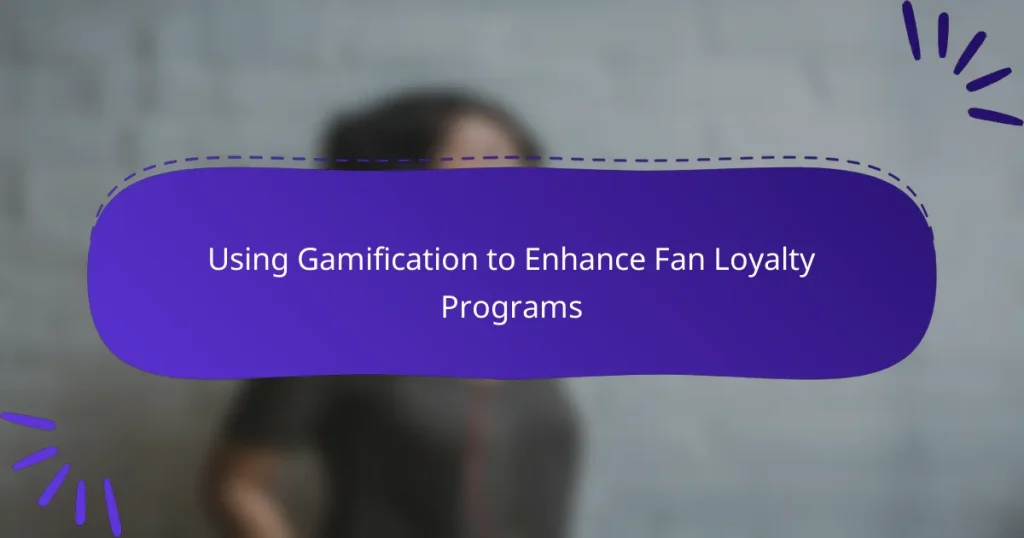Gamification can significantly enhance fan loyalty programs by transforming them into more engaging and rewarding experiences. By incorporating game-like elements such as point systems, challenges, and tiered memberships, organizations can motivate fans to interact with their brand more frequently and meaningfully, ultimately deepening their loyalty.

How can gamification improve fan loyalty programs?
Gamification can significantly enhance fan loyalty programs by making them more engaging and rewarding. By incorporating game-like elements, organizations can motivate fans to interact more frequently and meaningfully with their brand.
Increased engagement through interactive experiences
Interactive experiences, such as quizzes, challenges, and leaderboards, can boost fan engagement in loyalty programs. These elements encourage fans to participate actively rather than passively consuming content.
For example, a sports team might create a trivia game where fans earn points for correct answers about the team’s history. This not only entertains but also fosters a deeper connection with the team.
Enhanced customer retention with rewards systems
Rewards systems that incorporate gamification can lead to improved customer retention. By offering points, badges, or exclusive access as fans engage with the program, organizations can create a sense of achievement and loyalty.
For instance, a concert venue might reward fans with points for attending events, which can later be redeemed for discounts on future tickets or merchandise. This creates a cycle of engagement that keeps fans coming back.
Personalized experiences based on user behavior
Personalization is key in gamified loyalty programs, as it tailors experiences to individual fan preferences and behaviors. By analyzing user data, organizations can offer customized challenges and rewards that resonate with each fan.
For example, if a fan frequently attends soccer matches, the program could provide them with exclusive content or rewards related to soccer. This targeted approach enhances the overall fan experience and strengthens loyalty.
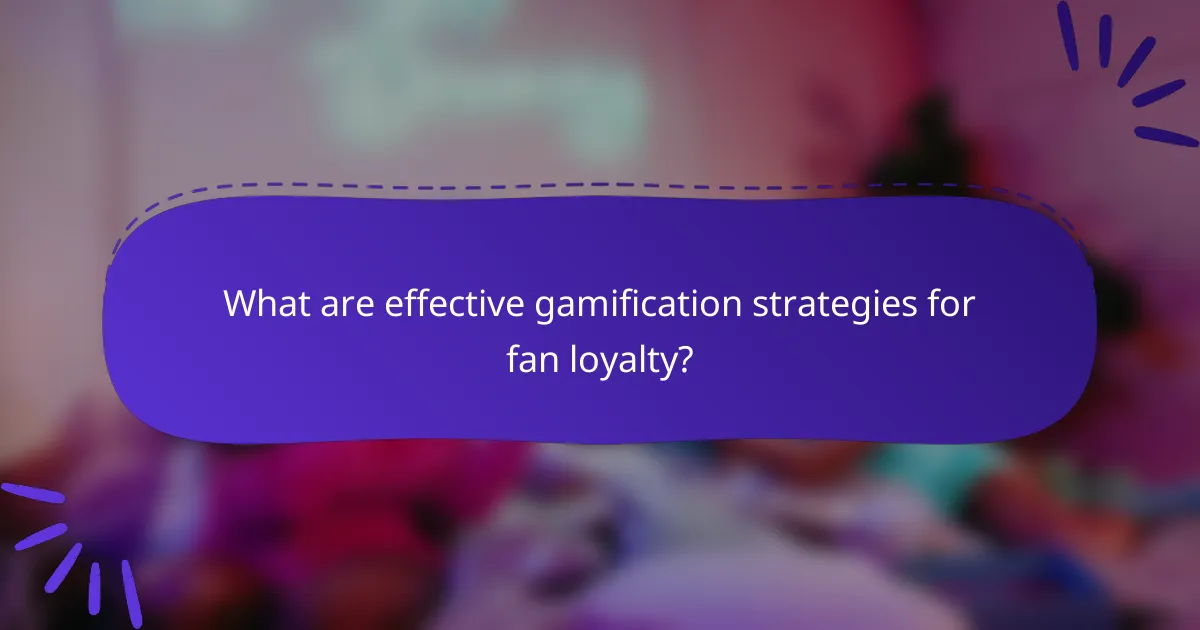
What are effective gamification strategies for fan loyalty?
Effective gamification strategies for fan loyalty include engaging fans through point-based reward systems, challenges, competitions, and tiered membership levels. These strategies create a more interactive experience, encouraging fans to participate actively and deepen their loyalty to the brand or team.
Point-based reward systems
Point-based reward systems incentivize fans by allowing them to earn points for various activities, such as attending events, making purchases, or engaging on social media. Fans can then redeem these points for exclusive merchandise, discounts, or experiences, enhancing their connection to the brand.
To implement a point-based system, consider setting clear rules for earning and redeeming points. For example, fans might earn 10 points for every dollar spent, and 100 points could be exchanged for a special event ticket. Ensure the system is easy to understand and track, possibly through a mobile app or website.
Challenges and competitions among fans
Challenges and competitions create excitement and foster community among fans. By organizing events such as trivia contests, fantasy leagues, or social media challenges, fans can compete for prizes while engaging with the brand and each other.
When designing these competitions, consider varying the difficulty and types of challenges to appeal to different fan segments. For instance, a trivia contest could cater to long-time fans, while a social media challenge might attract newer supporters. Regularly updating challenges keeps the experience fresh and encourages ongoing participation.
Tiered membership levels
Tiered membership levels reward fans based on their engagement and loyalty, creating a sense of exclusivity. Fans can progress through levels by accumulating points or completing specific activities, unlocking additional benefits at each tier, such as early access to tickets or exclusive content.
To establish effective tiers, define clear criteria for advancement and ensure that the rewards at each level are desirable. For example, a basic tier might offer standard discounts, while a premium tier could provide VIP experiences. This structure not only motivates fans to engage more but also fosters a stronger community as members strive to reach higher levels together.
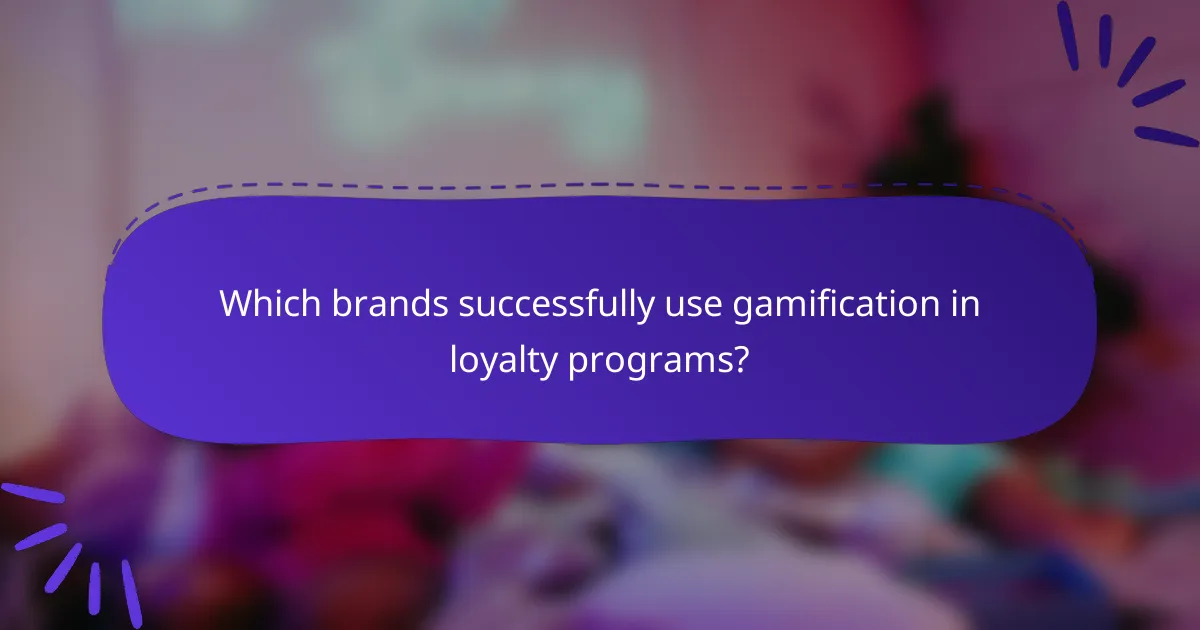
Which brands successfully use gamification in loyalty programs?
Several brands have effectively integrated gamification into their loyalty programs, enhancing customer engagement and retention. These programs often use points, challenges, and rewards to motivate participation and foster a sense of community among users.
Starbucks Rewards program
The Starbucks Rewards program employs gamification by allowing customers to earn stars for each purchase, which can be redeemed for free drinks and food items. Members can also achieve different tiers, unlocking additional benefits as they accumulate more stars.
To maximize engagement, Starbucks frequently introduces limited-time challenges and promotions, encouraging members to earn bonus stars. This strategy not only boosts sales but also creates a fun and interactive experience for customers.
Nike’s NikePlus membership
NikePlus enhances customer loyalty through gamified features like personalized challenges and rewards for achieving fitness goals. Members can track their workouts, earn badges, and participate in exclusive events, fostering a strong community around the brand.
By integrating social sharing options, Nike encourages users to share their achievements, further promoting brand visibility and loyalty. This approach not only motivates individuals but also builds a supportive network of fitness enthusiasts.
Sephora’s Beauty Insider program
Sephora’s Beauty Insider program utilizes gamification by offering points for purchases, reviews, and social media engagement. Customers can earn rewards such as discounts, exclusive products, and invitations to special events based on their point accumulation.
Sephora also introduces tiered membership levels, which incentivize customers to engage more with the brand. The program’s interactive elements, such as birthday gifts and seasonal promotions, keep members excited and invested in their loyalty journey.

What metrics measure the success of gamified loyalty programs?
Success in gamified loyalty programs can be measured through several key metrics that reflect customer behavior and engagement. These metrics include customer retention rates, engagement levels and participation rates, and average order value increase, each providing insights into how effectively the program fosters loyalty.
Customer retention rates
Customer retention rates indicate the percentage of customers who continue to engage with a brand over time. A successful gamified loyalty program can significantly boost these rates by creating incentives for repeat purchases and ongoing interaction. For example, brands might see retention rates improve by 10-30% after implementing gamification strategies.
To effectively measure retention, track the percentage of returning customers over specific periods, such as monthly or quarterly. A common pitfall is failing to account for seasonal fluctuations, which can skew results. Regular analysis helps in understanding true retention trends.
Engagement levels and participation rates
Engagement levels and participation rates reflect how actively customers are involved in the loyalty program. High engagement often correlates with gamification elements like challenges, rewards, and leaderboards that motivate customers to participate. Brands can aim for participation rates of 20-50% among their loyalty program members.
To measure engagement, monitor metrics such as the frequency of logins, challenge completions, and reward redemptions. Avoid overcomplicating the program, as excessive complexity can deter participation. Simple, clear rules and attractive rewards can enhance engagement.
Average order value increase
Average order value (AOV) increase measures the average amount spent by customers per transaction. Gamified loyalty programs can encourage customers to spend more by offering rewards for reaching spending thresholds or completing challenges. Brands may observe AOV increases of 5-15% as a result of effective gamification.
To track AOV, calculate total revenue divided by the number of orders over a specific timeframe. Focus on creating tiered rewards that incentivize higher spending without alienating budget-conscious customers. Regularly review AOV trends to adjust strategies and maximize effectiveness.
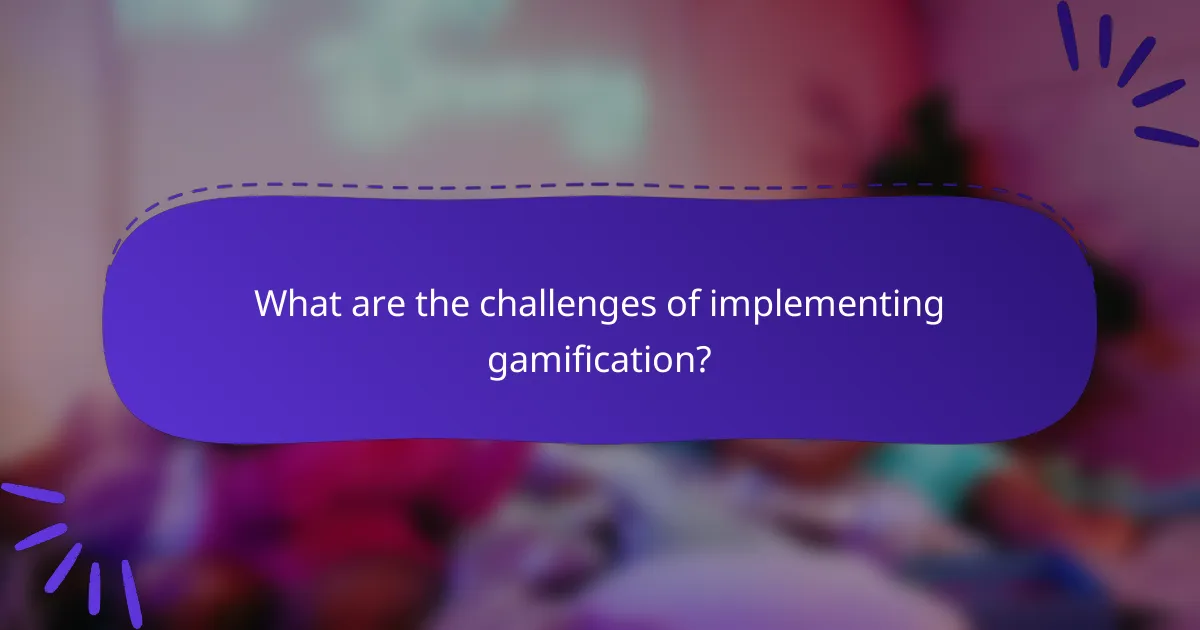
What are the challenges of implementing gamification?
Implementing gamification in fan loyalty programs presents several challenges that can hinder effectiveness. Key issues include balancing entertainment with valuable rewards, ensuring data privacy, and addressing initial customer resistance.
Balancing fun with meaningful rewards
To successfully gamify a loyalty program, it is essential to create a balance between enjoyable experiences and meaningful rewards. If the game elements are too entertaining without substantial benefits, customers may lose interest. Consider integrating tiered rewards that increase in value as participants engage more deeply.
For example, offering small incentives like discounts or exclusive merchandise for completing simple tasks can motivate participation while maintaining interest. Ensure that rewards are relevant to your audience to enhance their perceived value.
Ensuring user data privacy and security
Data privacy and security are critical when implementing gamification, especially in loyalty programs that collect personal information. Organizations must comply with regulations such as GDPR in Europe or CCPA in California, which mandate transparency in data usage and protection measures.
To safeguard user data, employ encryption and secure storage solutions. Additionally, communicate clearly with users about how their data will be used and provide options to opt out of data collection if desired.
Overcoming initial resistance from customers
Many customers may initially resist engaging with gamified loyalty programs due to skepticism or unfamiliarity. To overcome this barrier, clearly communicate the benefits of participation and provide a straightforward onboarding process.
Consider offering a limited-time promotion or bonus points for early adopters to encourage sign-ups. Engaging storytelling and relatable content can also help ease customers into the gamified experience, making it feel more accessible and appealing.
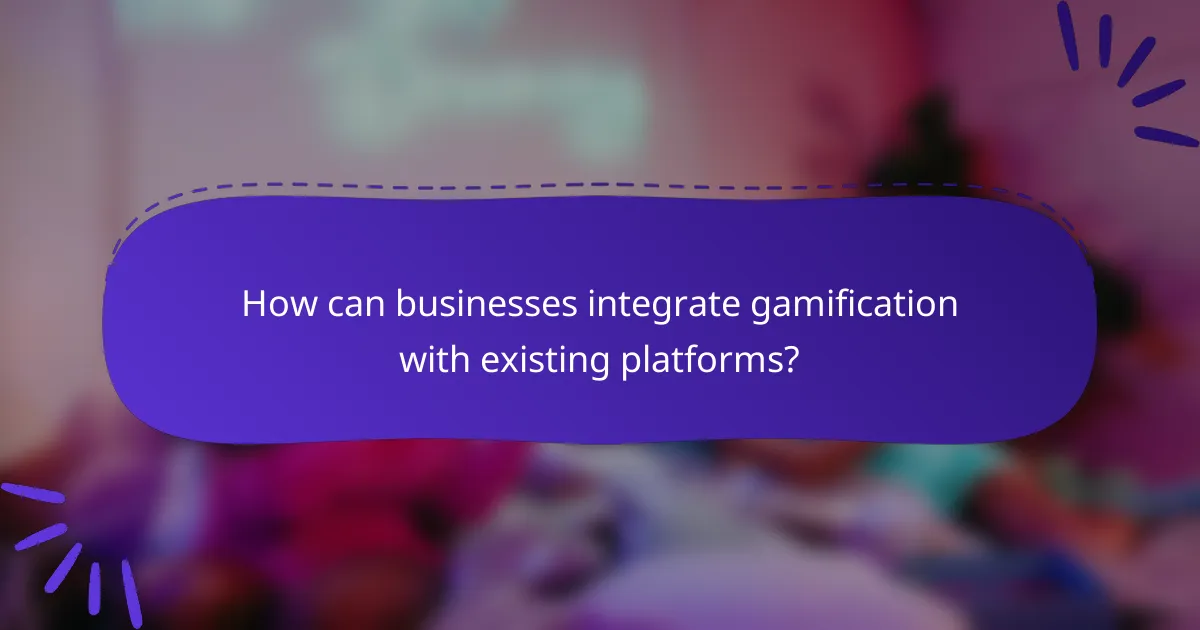
How can businesses integrate gamification with existing platforms?
Businesses can enhance their loyalty programs by integrating gamification elements into existing platforms, creating a more engaging experience for customers. This integration typically involves using technology to incorporate game-like features such as rewards, challenges, and leaderboards into loyalty systems.
Using APIs for seamless integration
Application Programming Interfaces (APIs) are crucial for integrating gamification with existing platforms. They allow different software systems to communicate, enabling businesses to add gamified features without overhauling their current infrastructure. For example, a retail app can use an API to connect with a gamification service that tracks customer points and rewards.
When selecting APIs, consider factors such as ease of use, documentation quality, and support. A well-documented API can significantly reduce development time and help avoid common pitfalls during integration.
Choosing compatible loyalty management software
Choosing the right loyalty management software is essential for effective gamification integration. Look for software that supports gamification features, such as point systems, badges, and social sharing options. Compatibility with existing systems ensures a smoother transition and better user experience.
Evaluate software options based on their flexibility, user interface, and the ability to customize gamification elements. Popular choices often include platforms that offer built-in gamification tools or allow for easy integration with third-party gamification services.
